Musikmesse 2015: 12 new Radial DI/switching boxes
Problem-solving boxes, channel strips and hum-killers
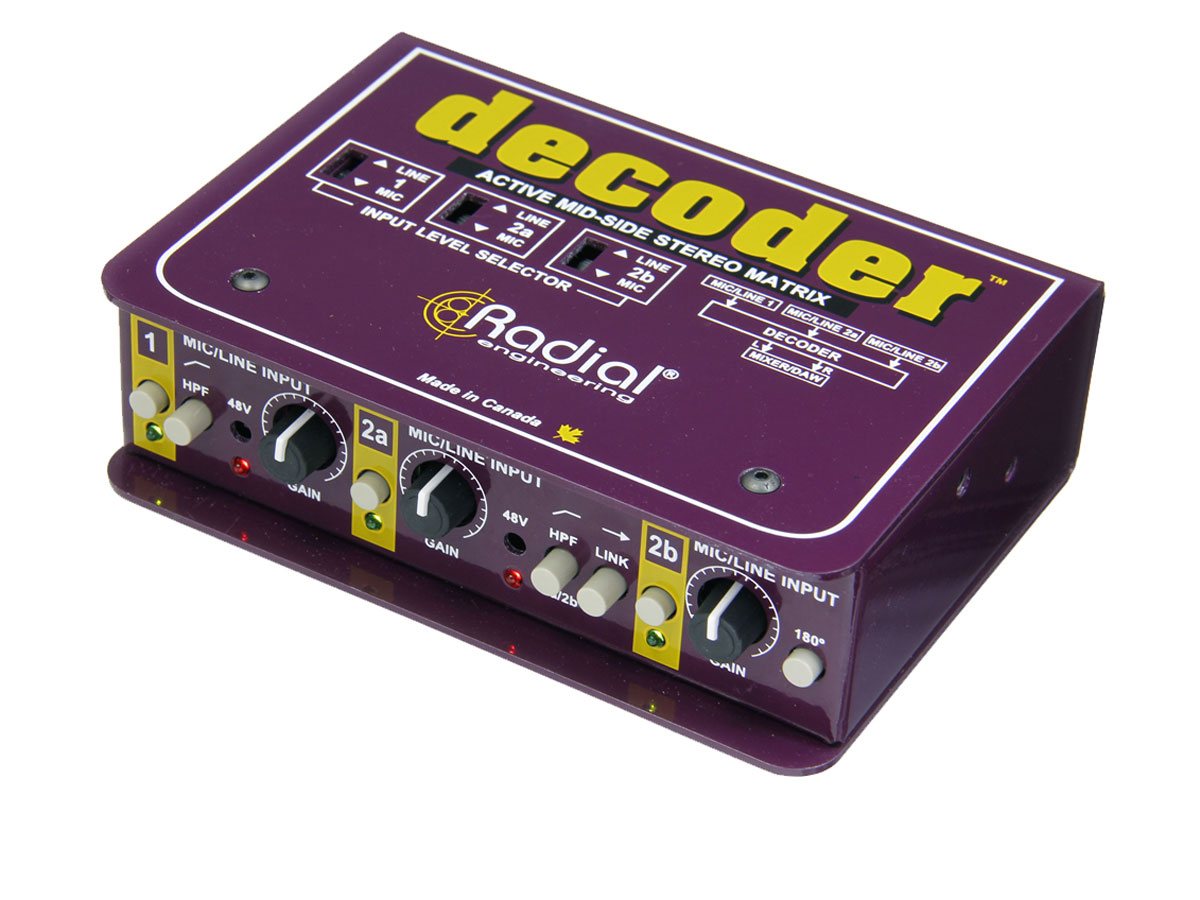
Radial Decoder
MUSIKMESSE 2015: Radial Engineering has unveiled a killer line-up of clever new tools for engineers, guitarists and other niche musician needs, including phantom power supplies, DI boxes, stereo isolators and a new version of the BassBone bass control centre.
Browse the gallery to view all the new products and read the full press releases, beginning with the Decoder, below...
Radial Decoder press release
Vancouver, BC - Radial Engineering Ltd. is pleased to announce the Decoder, a self contained MS (mid-side) interface, is now shipping.
The Decoder makes it easy to create exceptional stereo imaging when combining a mic with a second middle microphone. Radial Product Specialist, Ryan Juchnowski explains: "When we started working on the Decoder, we knew full well that a savvy engineer can pull together an MS patch using a traditional console, but we felt that there are a number of users who would prefer to have a simple 'plug and play' kit to do the job. Once we got started, we had so much fun during audio tests that we became convinced this would be a real treat to use for those with smaller studios where patching facilities may be limited or for those who plan to Reamp using pre-recorded tracks."
The Decoder begins with three XLR inputs with input-1 for a center mic, and input-2 (a) for a single output figure 8 mic or 2 (b) for those using two cardioid mics. Individual on-off switches and level controls for all three inputs are conveniently located on the front panel. A recessed 48V phantom power switch may be activated to supply DC for condenser microphones. A high-pass filter may also be engaged to eliminate excessive low frequency rumble and improve stereo focus. When using two separate microphones to create a figure 8 pattern, a 180° switch is engaged to reverse the polarity of mic 2B. Top mounted selector switches enable the Decoder to be used with microphones or line level sources when applying MS imaging to pre-recorded tracks.
As with all Radial products, the Decoder is made from 14 gauge steel to handle the abuse of being on the road. A unique book-end design creates a protective zone around the front panel switches and potentiometers keeping them safe from overzealous roadies. The internal I-beam construction is tremendously rigid to assure the sensitive internal PC board will not torque - thus preventing premature development of cold solder joints.
The Decoder may also be rack mounted by using the optional Radial SA rack-mount kit.
MAP for the Decoder is $349.99 USD.
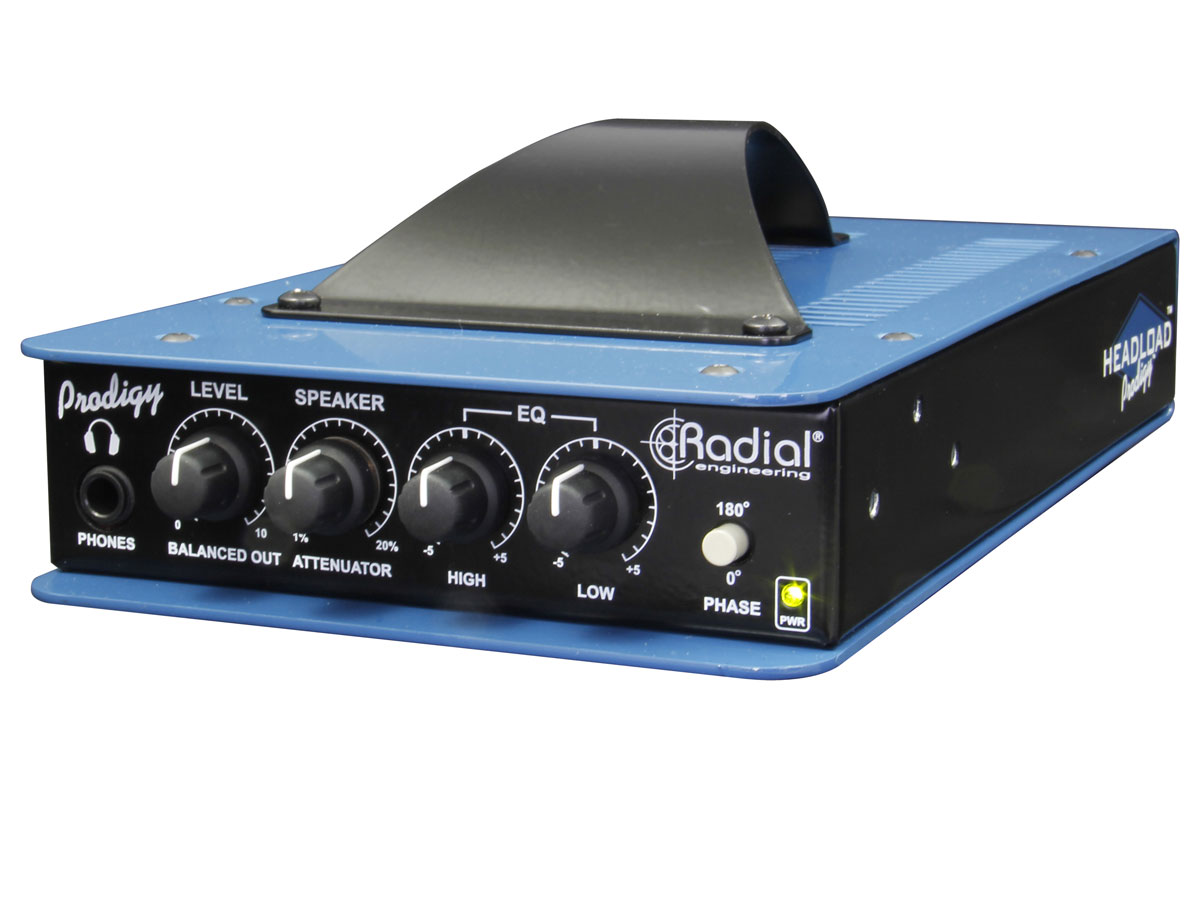
Radial Headload Prodigy
PRESS RELEASE: Vancouver, BC - Radial Engineering Ltd. is pleased to announce the Headload Prodigy - a combination load box and DI that enables one to drive a guitar amp at a higher output in order to maximize the tone, yet produce a lower stage volume when needed.
Like the original Headload, the Prodigy employs custom made cement-encrusted resister coils to covert the excessive power from the amplifier to heat and is able to withstand up to 100 watts RMS. The Prodigy may be used in three different ways, depending on the need. First, it may be used as a simple direct box connection via a built-in Radial JDX Reactor. This combines a reactive load with a proprietary filter bank to emulate the tone of a 4 x 12 half stack using a Shure SM57. The second is as a load box where you can attenuate the output from 20% down to 1% for use on quiet stages. Third, the prodigy can be used without a cabinet for completely silent recording. In all cases, the balanced JDX output is available. This is transformer isolated to eliminate hum and buzz caused by ground loops and equipped with a pin-1 ground lift and polarity reverse. One merely connects the head to the Headload Prodigy and the desired speaker output to suit.
In order to optimize the playing experience for in-ear monitors, a dual band EQ on the front panel is included. To add greater connectivity options, two additional ¼" outputs are included with one that is post EQ, post JDX, the other pre EQ, pre JDX. These can be used to feed additional amplifiers, effects racks or recording systems and adjusted using the front panel level control. This same control is used to adjust the built-in headphone amplifier.
Housed in 14-gauge steel, the Headload Prodigy features Radial's unique book-end design that creates protective zones around the switches and controls. An internal I-beam construction adds tremendous rigidity, protecting the internal PC board from torque which could lead to solder joints going cold prematurely. One or two Prodigys may be rack-mounted into a single 19" rack space using an optional rack kit. Power is supplied by an external 15VDC supply.
The Headload Prodigy will begin shipping May 2015. Estimated MAP $399.99 USD.
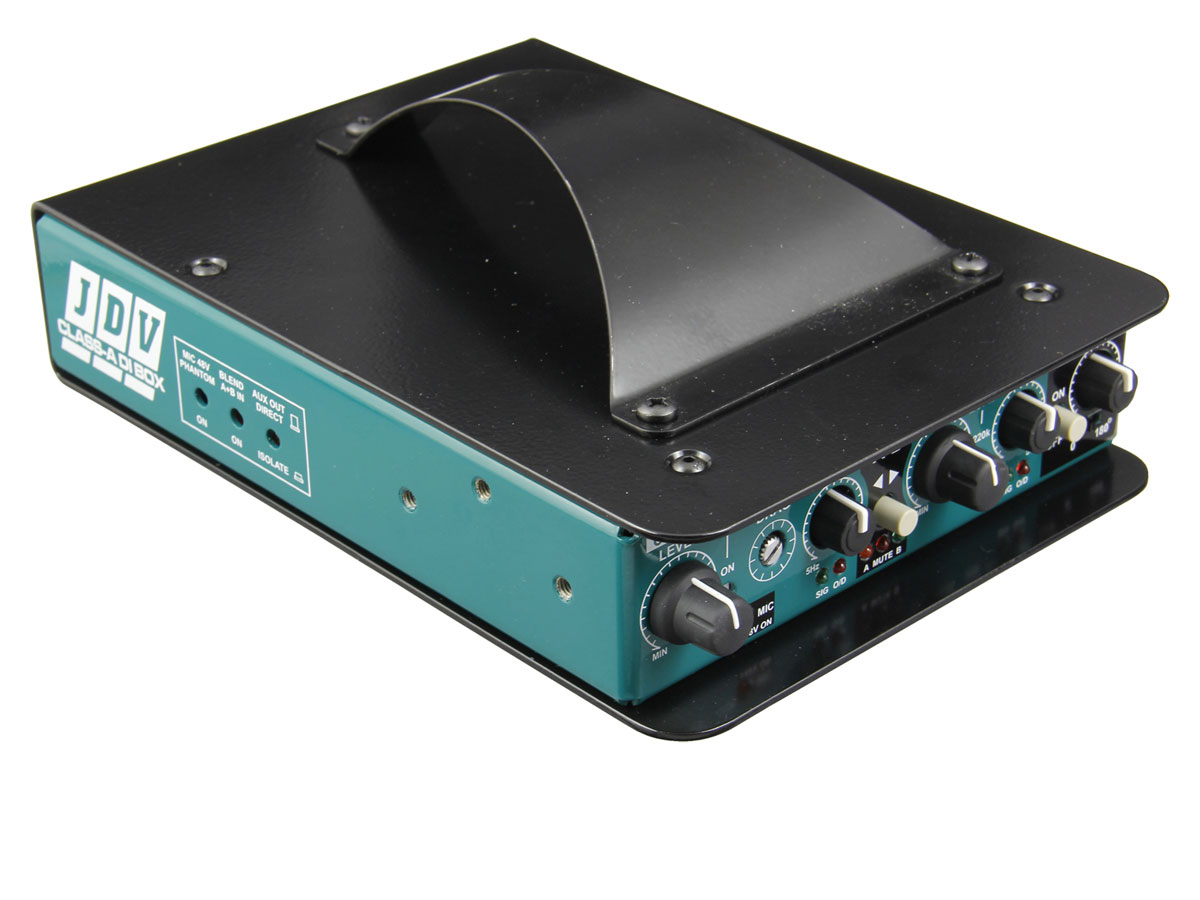
Radial JDV Mk5
PRESS RELEASE: Vancouver, BC - Radial Engineering Ltd. is pleased to announce a new generation JDV with what is likely the most ambitious set of features ever inside a direct box.
Radial President Peter Janis explains: "The origins of the JDV can be traced back to the 1980s when Vancouver was a hot spot for some of the most commercially successful recordings of all time including works by artists Bryan Adams, AC/DC, Metallica, Elton John, Aerosmith, Loverboy and Bon Jovi. It was also home to Bruce Fairbairn and Bob Rock. Little Mountain Studios was the epicenter."
"Behind the scenes was studio designer and technical whiz John Vrtacic. John was the guy that designed the monitors, modified and rebuilt the consoles and created some of the unique tools that set Little Mountain Studios apart. Artists would often talk about the amazing bass sound that John's custom-made direct box produced. What John had discovered was a way to buffer the signal without the use of negative feedback. I remember being in John's home laboratory as we were testing various direct boxes. He put up a square wave and showed me how others had overshoot and ringing while his design was exceptionally accurate."
"Soon after we launched the Radial JDI passive direct box, and I asked John's assistant Ron 'Obvious' Vermeulen to compare various direct boxes to prove that the JDI was best. During these tests, unbeknownst to me, Ron also tested John's custom made unit. He called me up and told me that John's box was so much better than the other active ones on the market that I should approach John to see if he would sell me the design. He did and the first generation JDV (V for Vrtacic) was born."
The JDV Mk5™ is a 100% discrete class-A active direct box that retains the original zero-negative feedback topology, yet adds an incredible array of features.
The new design begins with two inputs, each with a volume control signal presence and overload LEDs, plus a fully variable high pass filter to tame excessive bottom end resonance. Selecting between the two inputs can be done using the front panel AB select or by adding an optional JR2 remote control. This also enables the user to mute the output to change instruments or quiet the system down between sets.
Although capable of handling any type of signal, the JDV Mk5 is primarily intended for use with bass and acoustic instruments.This means that the two inputs have been optimized to handle any type of instrument, be it electric or acoustic with an eye on making it easy to switch between them without losing a step!
Input-A is equipped with Drag™ control load correction that enables the artist to sweep the input range from 10-kohms up to 1-megohms.This is of particular importance when using bass guitar as it enables the artist to replicate the 'sound and feel' as if connected directly to the bass amplifier. A side-access 'mic select' activates a dedicated balanced TRS mic input to allow the JDV to be used with instrument mounted condenser microphones.This 'set & forget' switch is complimented with 48V phantom power with front panel LED indicator. A unique safety feature ensures phantom power will not be mistakenly activated which otherwise could harm a pickup if connected in the wrong input.The safety feature can be bypassed by changing the position of an internal jumper.
Input-B is equipped with a load selector switch that toggles between 200-kohms for passive basses and 10-megohms for use with piezo transducers. Elevating the impedance on a piezo extends the frequency response and smoothes out the transient response for a more natural sound. Where things get really exciting is when you combine the two channels. A side access 'blend' function turns both on at the same time so that you can combine a magnetic pickup with a piezo or mix a microphone with a pickup.The built-in Phazer™ lets you align the two audio sources so that you can find the sweet spot and deliver what can only be described as the most natural sound ever from an electrified instrument.
The rear panel is also jam-packed with features: In addition to the two unbalanced instrument inputs and the balanced mic input, a thru-put is provided to feed an on-stage amplifier. This is complimented with a side-access switch that can introduce an isolation transformer into the signal path should a ground loop be encountered. A dedicated tuner output has also been included to provide the artist with consistent visual feedback even when the JDV Mk5 is muted.
The balanced XLR output is equipped with a 180° polarity reverse to either phase align the PA system with the on stage amp or help eliminate acoustic hot spots on stage that could otherwise cause feedback. To reduce stage noise, a ground lift switch eliminates hum and buzz caused by ground loops while a transformer may be inserted into the XLR signal path to provide 100% isolation. When recording, the engineer can select between direct or transformer isolated outputs or elevate the output to a fully balanced professional +4dB line level to feed a recorder without having to pass the signal through an external preamp.
These features combine with what many consider to be the finest sounding direct box ever made. Janis closes with this: "When artists plug into the JDV, they often comment how good it sounds. We tell them it is not the JDV that sounds so good, only that this is the first time you have ever heard your bass without distortion, artefact or constraint."
The Radial JDV Mk5 will start shipping in May 2015. Estimated MAP $449.99 USD.
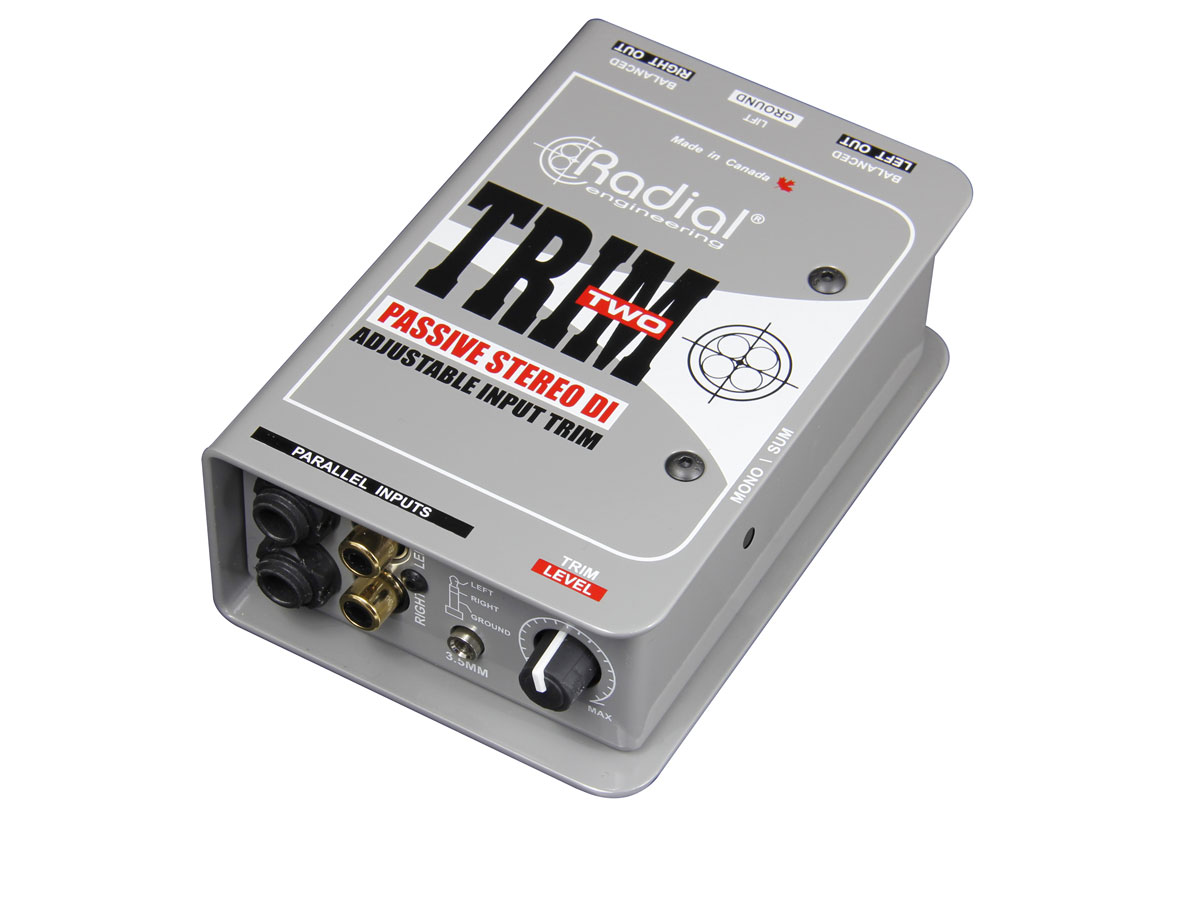
Radial Trim-Two
PRESS RELEASE: Vancouver, BC - Radial Engineering Ltd. is pleased to announce the Trim-Two, a passive stereo isolator designed to simplify the use of laptop computers for keyboard players, DJs and audio-visual presenters by providing a 'ready access' volume control for on-the-fly adjustments when performing on a live stage.
Radial Sales Manager Roc Bubel explains: "In recent years, there has been a steady shift towards the use of a laptop as a sound source for live performance instead of a CD player, keyboard or sound module. For instance, a laptop is easily combined with a master keyboard using a USB interface to provide a huge selection of digitally generated sound files plus a suitable data screen that can then be controlled as if a sound module. Where these setups fall short is the required use of a mouse for simple tasks such as adjusting the volume. The Trim-Two is a passive device that at once makes adjusting the volume easy while providing an isolated output to feed a PA system."
The design begins with dual ¼" jacks, left and right RCAs and a stereo 3.5mm input. These are wired in parallel to allow the signal to be split off to feed an alternate signal path such as monitors. Inside, two great sounding Eclipse transformers do the work of isolating and balancing the signal. These 'passive engines' deliver a linear frequency response from 20Hz to 18kHz and are capable of handling up to +15dB signal levels thus providing typical -10dB keyboards and consumer level devices with plenty of headroom. An easy access front panel stereo level control makes adjusting the volume a snap.Play your sound files using the Trim-Two by connecting it from the headphone output of your tablet to the 3.5mm input on the Trim-Two. Use the volume control to adjust the level and avoid distortion.
Transformers provide galvanic isolation between the source and the destination and are extremely effective at eliminating ground loops. One merely connects the source to the Trim-Two and then the male XLR outputs to the PA system. As the Trim-Two is completely passive, no power is required.
Made in Canada from heavy duty 14 gauge steel, the Trim-Two features Radial's unique book-end design that creates protective zones around the connectors and controls. Inside, the unique I-beam frame protects the sensitive inner workings from potential damage that could torque the PC board and cause solder points to prematurely go cold. The steel casing also provides shielding against external magnetic fields.
MAP for the Trim-Two is $149.99 USD.
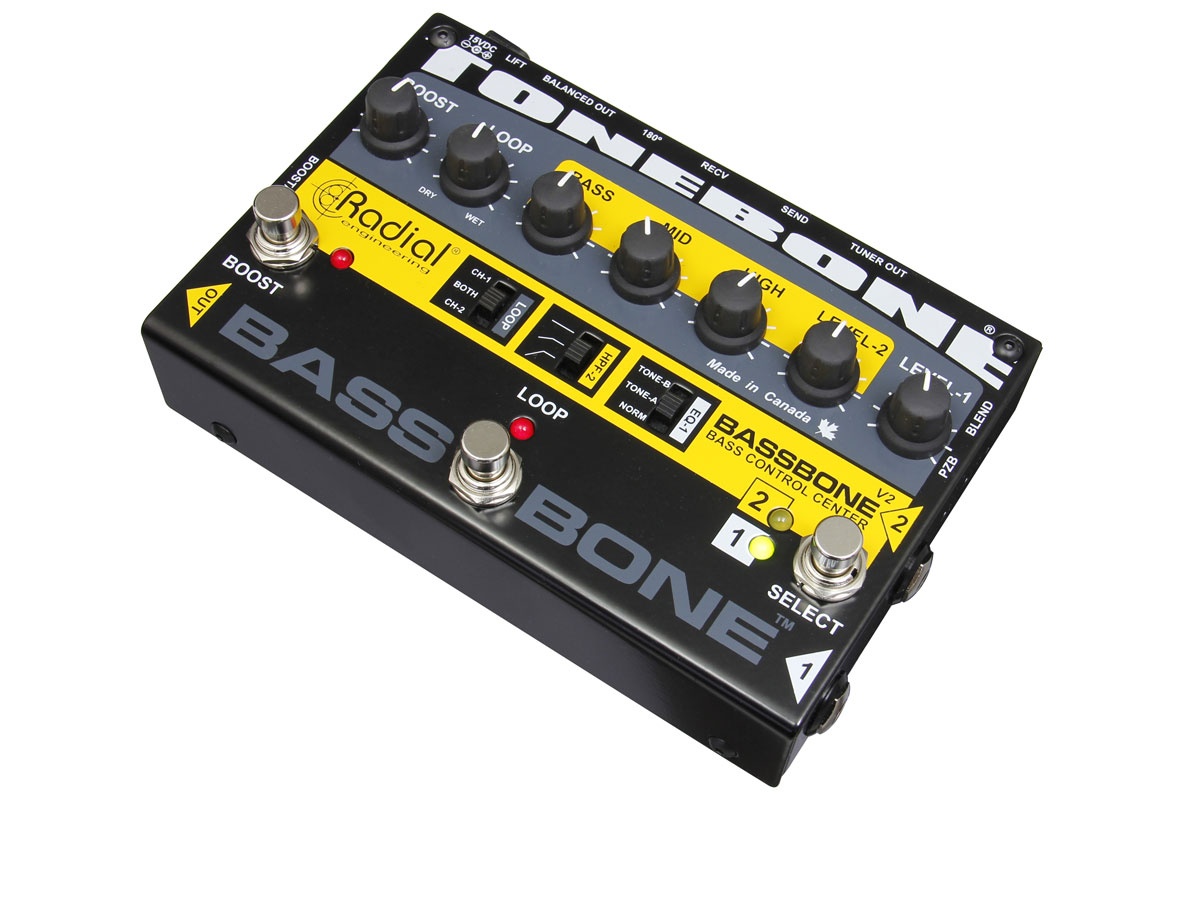
Radial Bassbone V2
PRESS RELEASE: Vancouver, BC - Radial Engineering Ltd. is pleased to announce the Bassbone V2, a second generation Bassbone that features a dedicated effects loop, combination power booster-mute footswitch and piezo optimized input for upright bass.
Radial Sales Manager Roc Bubel explains: "We recently launched the Bassbone OD which has gained tremendous attention from many of the world's most prominent bass players. Instead of dropping the original Bassbone, we felt that there were many who preferred the smaller footprint and focussed feature set. The Bassbone V2 was developed for this crowd."
The Bassbone V2 is a two channel bass control center that features the same award winning audio circuit that has made the Bassbone popular with artists as diverse as Marcus Miller, John Patitucci and Victor Wooten. It features a toggle switch to select between two basses or switch between channels like a two channel amp. A full effects loop with send and receive jacks is complimented with a wet-dry control that enables the artist to mix-in as much of the effect as desired without losing the natural bass tone. A third footswitch works double duty as either a power booster or a mute switch. This lets you accentuate passages for solos or if you prefer to 'ride steady' in the background, can be used for quiet on-stage tuning using the dedicated tuner output. A main output is used to feed the stage amp while the built-in Radial DI box feeds the PA system or recording workstation.
Like all Radial products, the Bassbone V2 is made from 14 gauge steel for extra durability and comes complete with 15VDC power supply.
The Bassbone V2 is now shipping with a MAP of $289.99 USD.
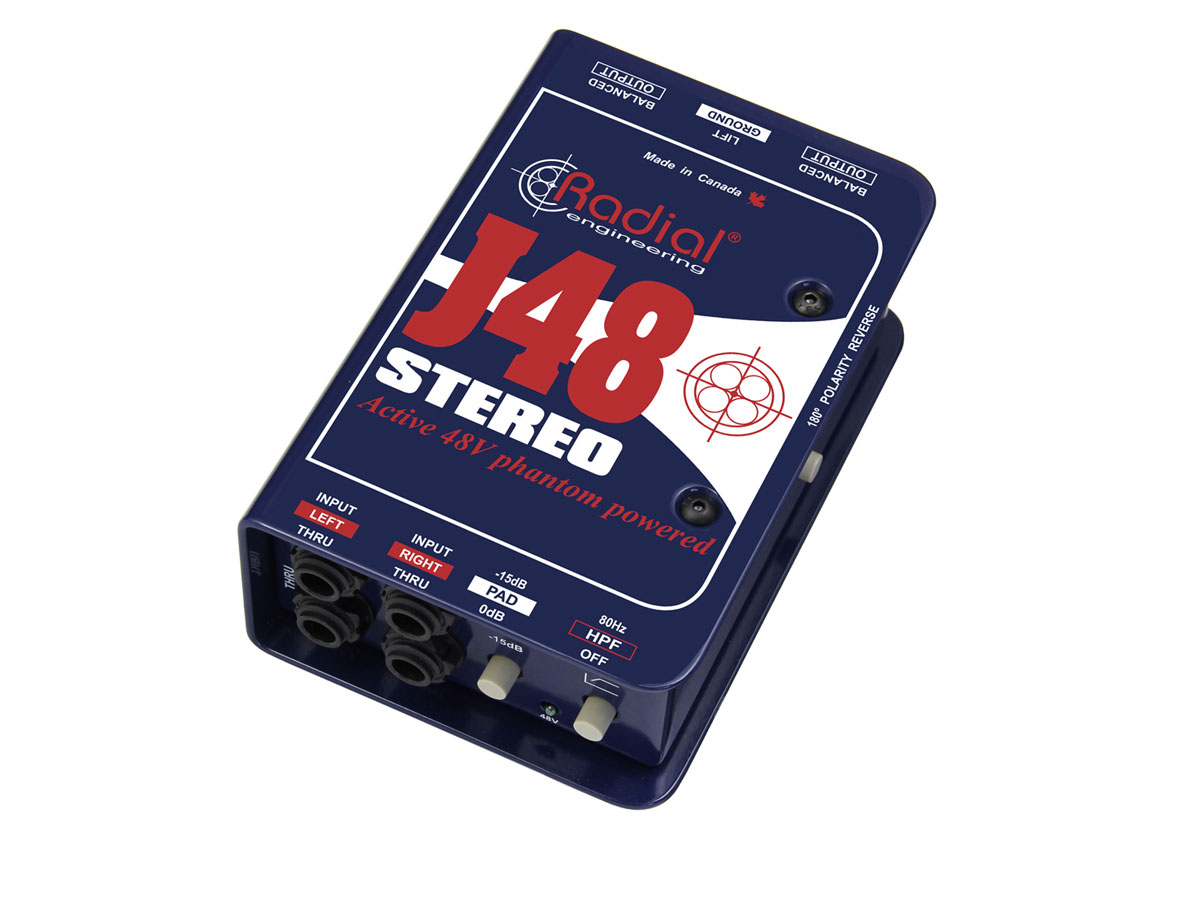
Radial J48 Stereo
PRESS RELEASE: Vancouver, BC - Radial Engineering Ltd. is pleased to announce the Radial J48 Stereo active direct box is now shipping.
It's the first stereo direct box manufactured by the company. President Peter Janis: "Since the Radial J48's release in 2001, it has become the world's most popular active direct box for live touring. Today it can be found on stages as diverse as Paul McCartney, Linkin Park, The Who, Madonna and on live recordings by Tommy Emmanuel. What makes the J48 unique is the internal switching power supply. This at once elevates the internal rail voltage for greater headroom and less distortion while providing a method to lift the audio ground without losing phantom power. This produces a wider frequency response, a higher output level over a passive DI and eliminates having to deal with batteries going dead in the middle of a show. For years, we have been asked to come up with a stereo version and we finally got round to it."
Like all Radial products, the J48 Stereo begins with rugged 14 gauge steel construction and a book-end design that protects sensitive switches and connectors from damage. The internal I-beam ensures the fragile internal PC board will not torque which could lead to premature 'cold solder joints' developing, causing joint failure. All connectors are made from glass-filled nylon and are insulated from each other. Extra duty nickel-silver contacts are employed that will not tarnish over time.
Inside, a unique power supply converts the 48 volt phantom, increasing the headroom for improved signal handling and lower distortion. This results in a linear frequency response that spans from 10Hz to 40kHz while being able to handle high output instruments such as a digital piano or active bass without choking. An additional -15dB pad may be engaged should the need arise. A built-in high-pass filter gently rolls off low frequencies below 80Hz to clean up mud and excessive resonance. This is augmented with a side-access 180° polarity reverse that can be handy when using the J48 Stereo with dual element pickups to either phase align the sources or eliminate hot-spots on stage that can cause feedback.
The other benefit of this unique design is the way the J48 Stereo handles hum and buzz caused by ground loops. The traditional solution to eliminating a ground loop is to lift the audio ground by disconnecting pin-1 at the XLR output. When this is done, the 48 volt phantom DC power from the console is shut off. Other manufacturers solve the problem by introducing a battery into the equation. Unfortunately batteries are inconsistent, and when they begin to drop power, it can severely affect the available voltage and resulting headroom. Instead, the J48 Stereo employs a DC to DC converter with a high frequency transformer that enables the audio ground to be lifted at the power supply. This does not shut off the phantom power and is invisible to the user.
With great sound and very low crosstalk, the J48 Stereo is equally suited for stereo instruments or may be used with two different instruments at the same time.
The J48 Stereo direct box has a MAP of $299.99 USD.
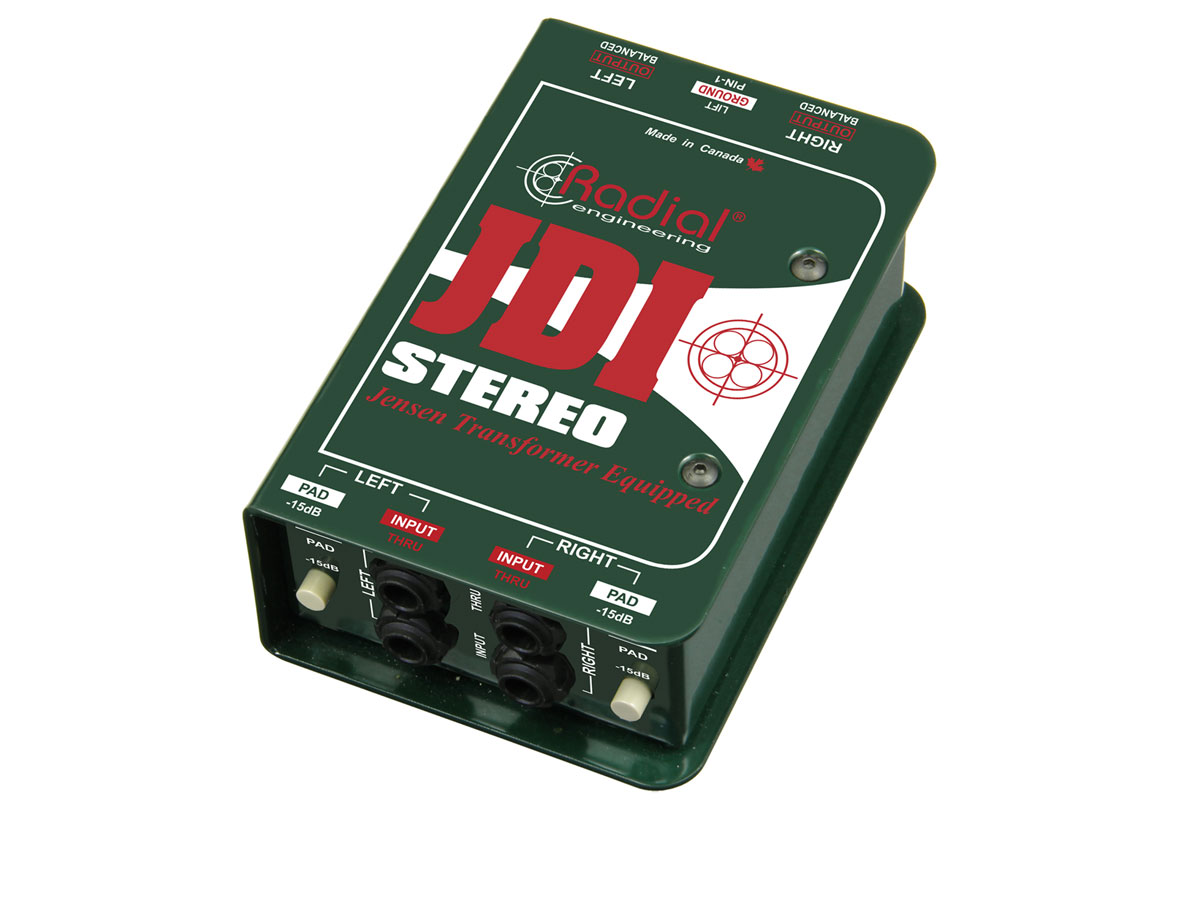
Radial JDI Stereo
PRESS RELEASE: Vancouver, BC - Radial Engineering Ltd.is pleased to announce the JDI Stereo direct box is now shipping.
According to company President Peter Janis: "Stemming back nearly 20 years, the Radial JDI has become the undisputed leader in high-end passive direct box technology and there is no question that the JDI Stereo is sure to follow suit."
"We have spent countless hours on top, behind and below concert stages, discussing the needs of today's most demanding technicians. One of the reoccurring themes is the use of two direct boxes to handle a stereo source. And although Radial has been producing stereo direct boxes such as the Duplex for years, the move towards compact setups to lower the cost of air travel has become an important attribute whose time has come. The JDI Stereo is simply the solution to a new problem that is based on economics."
The first off-the-line JDI Stereo was delivered to the Commodore Ballroom, a renowned music venue in Vancouver. The Commodore's FOH Paul Way likes the efficiency of the new DI: "The new Stereo JDI allows the Commodore to offer yet another high quality Radial DI option to our visiting engineers and artists. A stereo solution in a single classic package, very useful on a crowded stage or pedal board." Byron Lonneberg, The Commodore's Technical Director was quick to add: "Radial strikes again! The only thing better than a JDI is a Stereo JDI. Legendary quality and twice the capability in the same small package."
Features include input and thru-put ¼" connectors plus a -15dB input pad on each channel. This is supplemented with a ground lift switch that lifts pin-1 on the two XLR outputs to further reduce hum and buzz caused by ground loops. Built tough to handle the abuse of live touring, the JDI Stereo employs a 14-gauge steel I-beam inner frame and a unique book-end outer shell. The innovative design eliminates stress on the PCB, reducing opportunity for solder joints to go 'cold' while the outer shell creates a protective zone around the switches and connectors. The steel enclosure works with the transformer's mu-metal cans and internal Faraday shield to protect the sensitive inner workings from powerful magnetic fields such as those generated by stage amplifiers. This ensures the signal transfer is quiet and free from hum.
The Radial JDI Stereo MAP is $299 USD.
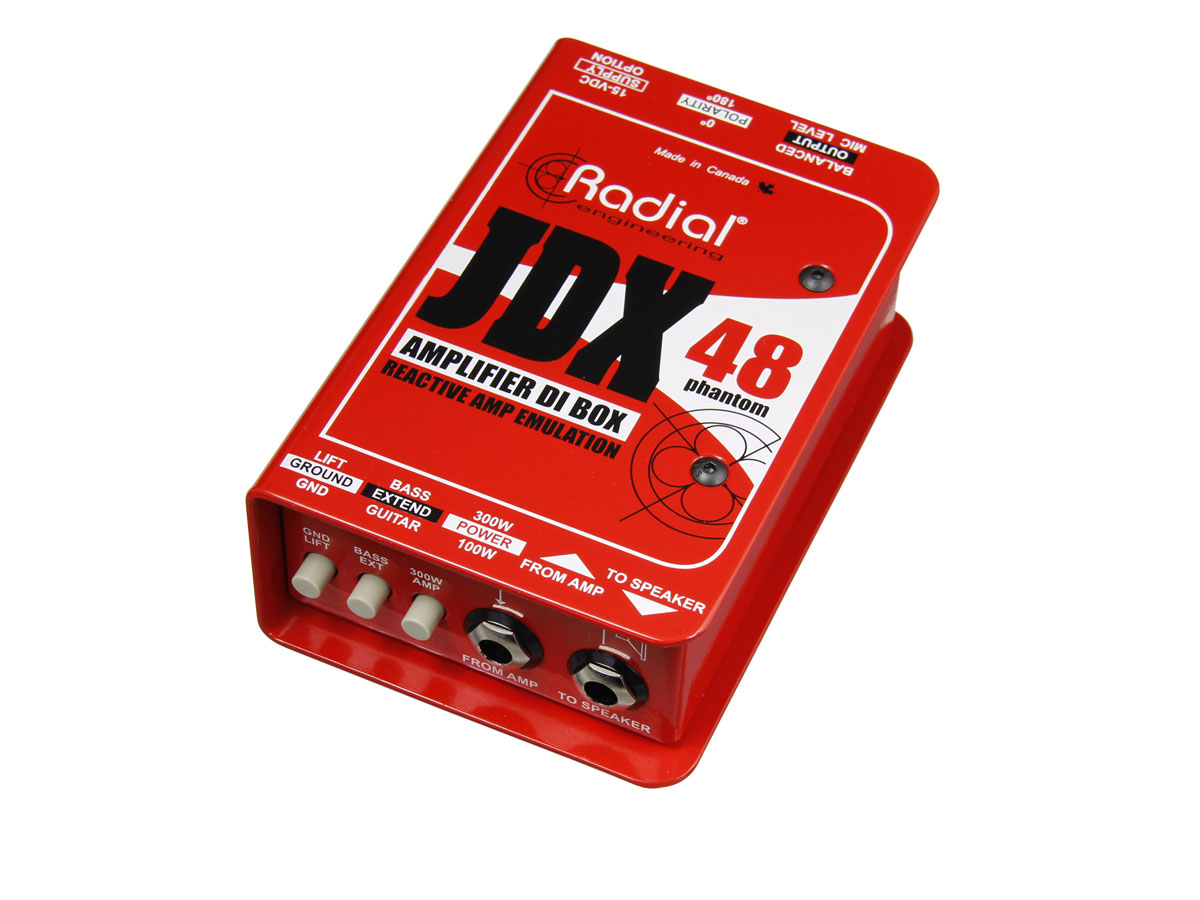
Radial JDX 48
PRESS RELEASE: Vancouver, BC - Radial Engineering Ltd. is pleased to announce a next generation version of the popular JDX Reactor amplifier DI.
Radial Product Specialist Jay Porter explains: "The JDX has become a staple in professional touring, clubs and houses of worship worldwide. While many engineers were initially skeptical because of previous bad experiences with different 'red boxes', the JDX has rapidly gained popularity thanks to its natural, consistent tone. It has also become a go-to piece for use with in-ear monitor systems, delivering a guitar tone that players love."
"As soon as we released the JDX, folks started asking us if there was any way to power the box using standard 48V phantom. The included 15V power supply was fine for most applications, but space and power outlets are always at a premium on stage. Plus carrying multiple power supplies for different areas of the world is painful for our touring clients. We started looking at ways to reduce the current draw of the JDX so it would run on phantom power without sacrificing the exceptional tone, and it wasn't easy! After several rounds of prototyping, we were finally able to reduce the current requirements of the Class-A circuitry with all of the tone intact."
"Another request was to increase the power handling of the JDX. While the original was designed for guitar amps with a 100 watt output, many folks loved using it with higher-powered amps such as the Ampeg SVT. While this was always possible at lower volumes, extra care needed to be taken to ensure that amplitude peaks did not exceed 100 watts."
The JDX 48's design begins with the same 100% discrete class-A circuitry and transformer-coupled reactive load found on the original. This captures both the sound from the amp head along with the back electromagnetic impulse from the loudspeaker. This produces a more realistic rendering than the usual resistive pad offered by other manufacturers. This signal is then processed via a carefully designed multi-stage filter to emulate the tone of a 4x12 half-stack cabinet when used with guitar, or a 8x10 cabinet when used with bass. The JDX 48 now also includes a Bass Extension switch for increased bottom end when desired, and a 100w/300w switch to change the input capability.
The ability to use 48 volt phantom, higher power amplifiers, and add a low frequency extension to the voicing makes the new JDX even more versatile than before.
The JDX 48 will begin shipping in May 2015 with a MAP price of $199.99 USD.
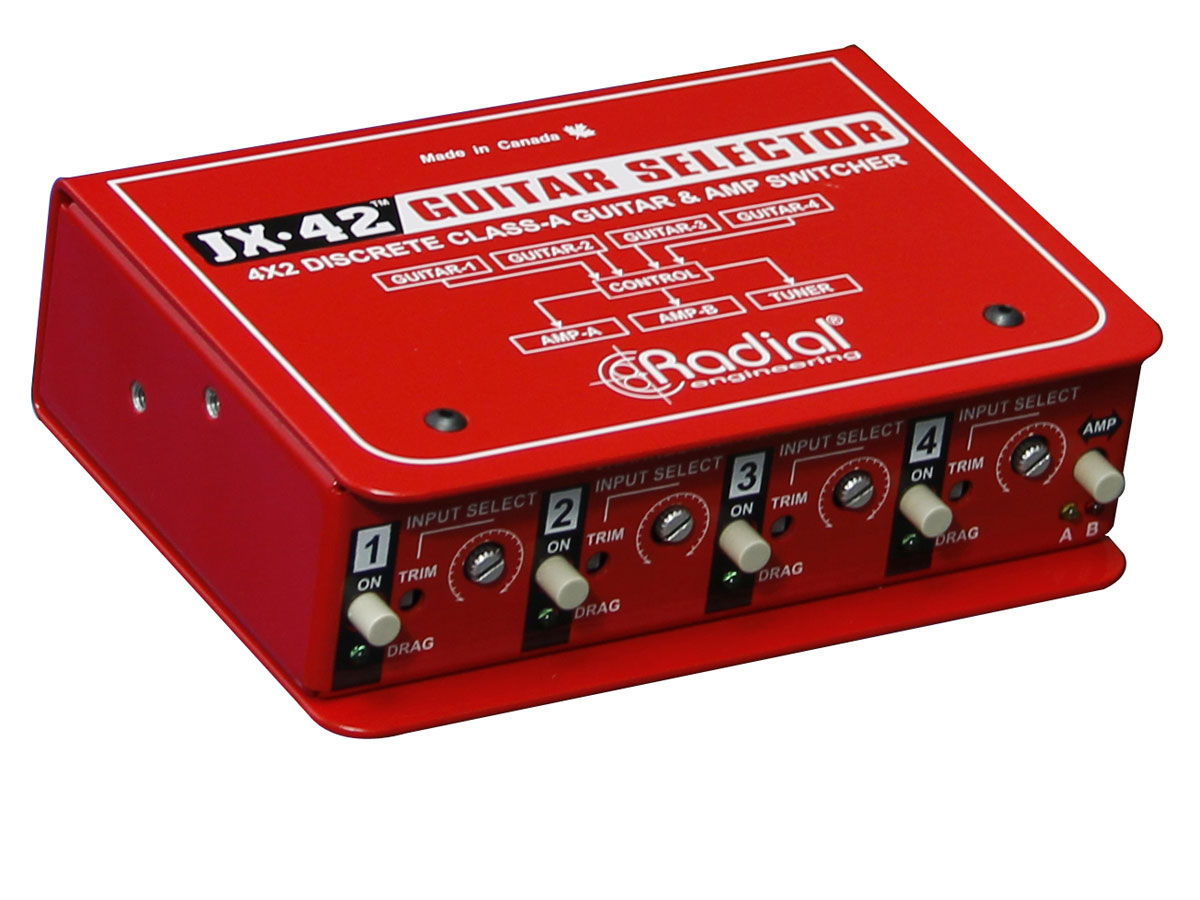
Radial JX42
PRESS RELEASE: Vancouver, BC - Radial Engineering Ltd. is pleased to announce the JX42, a compact switcher that is used to matrix four guitars and two amps in the studio or on a live stage.
According to Radial TSG (Technical Support Group) advisor Ryan Juchnowski: "Ever since we launched the JX44 Air Control guitar and amp switcher, we have received numerous requests to build a smaller, more affordable version. The JX42 is exactly that. It can handle up to four guitars and switch between two amps using the optional JR2 remote control. And at only $349.99 USD - it will surely become a favorite for backline techs everywhere!"
Made from 14 gauge steel, this compact switcher begins with Radial's trademark bookend design. This creates a protective zone around the switches and knobs to safeguard against the harsh environment of professional touring. The unique I-Beam construction adds tremendous rigidity to protect the internal circuit board from torque which could lead to premature cold solder joints. Optional rack ears allow one or two JX42s to be rack-mounted in a single 19" rack space.
Starting with the front panel, the four (4) input channels feature 'radio-style' on-off switches that immediately turn the previous channel off when the new channel is selected. These are complimented with easy-to-see LEDs for visual feedback on dark stages. Switching is done using opto-resistive couplers that ramp up and down the signal, eliminating any popping that could otherwise occur. This is particularly important when mating the JX42 with high gain amps and concert-level PA systems. Inside, Radial's award-winning 100% discrete class-A buffering circuit is employed to ensure absolute signal quality is maintained. Each input channel also sports a dual function 'set and forget' potentiometer that can be assigned as either a level control to match various active or passive guitar or bass signals, or can be set to Drag for precise load correction when using passive magnetic pickups. Drag™ control replicates the tone and feel as if connected directly to a guitar amp. The potentiometers are recessed in order to leave the front panel clear of obstructions so that they are not accidentally changed during a busy concert.
Connection to the JX42 is done using standard ¼" guitar jacks via the rear panel. Each input is accompanied by a dedicated thru output that allows the guitarist to mate a particular guitar with a specific amp or SGI extender to feed a distant pedalboard. When used with bass, the thru can be used to feed a Radial direct box to send a clean signal to the FOH position. There are two main stage amp outputs, of which the B output is transformer isolated to eliminate hum and buzz caused by ground loops. Selecting the amps may be done using a front panel AB selector switch or by connecting the optional JR2 remote footswitch via a TRS jack. Once connected, the JR2 derives its power from the JX42 which illuminates the AB select and mute LEDs. A dedicated tuner out mates with the mute footswitch for quiet on-stage tuning.
The JX42 is powered via a 15VDC supply for extra headroom which can be locked to secure the cable.
Proudly made in Canada, the Radial JX42 carries an anticipated MAP price of $349.99 USD and will be available beginning May 2015.
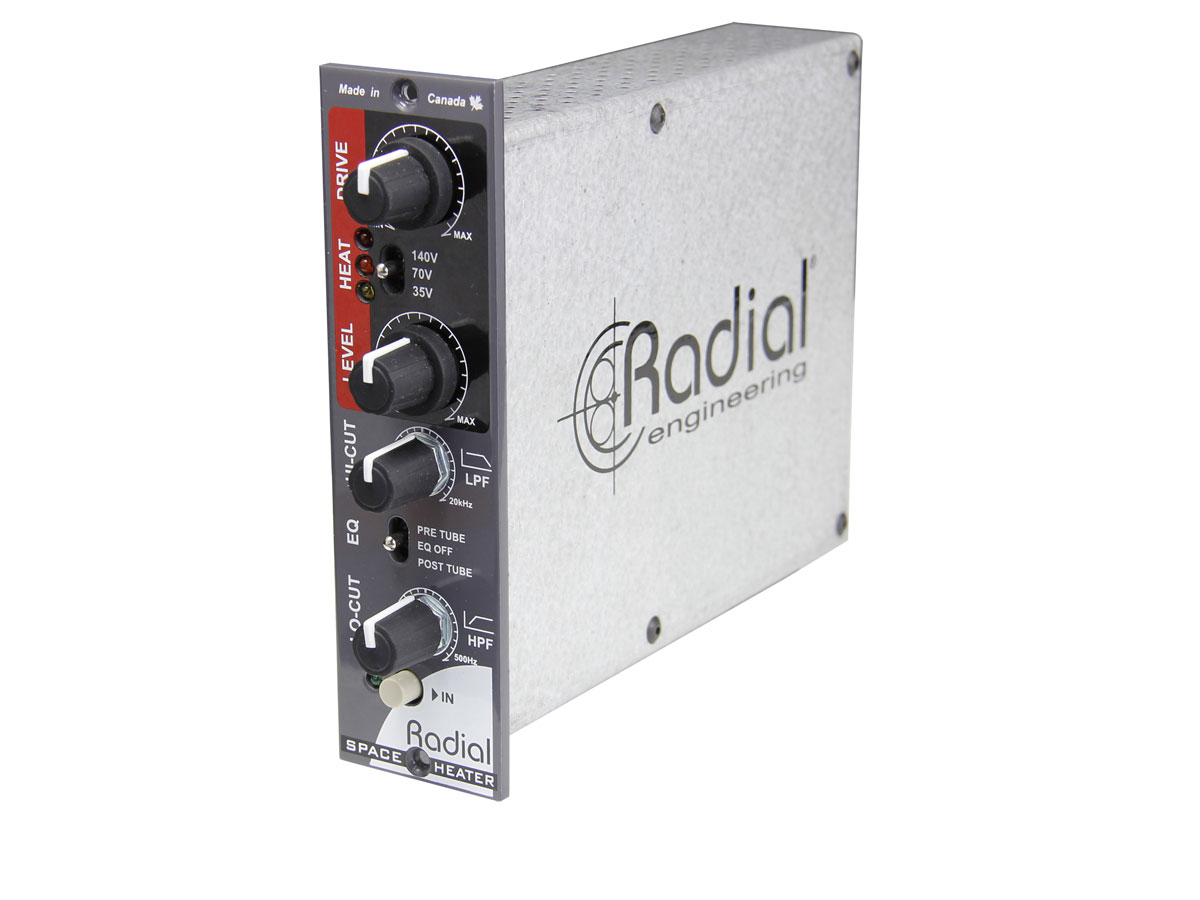
Radial Space Heater 500
Vancouver, BC - Radial Engineering Ltd. is pleased to announce the Space Heater 500, a single wide tube overdrive module for the Radial Workhorse and other 500 series racks.
The Space Heater 500 delivers natural tube crunch to drums, adds character to voice, and natural tube compression to bass and acoustic guitar. According to Radial product guru, Jay Porter: "When we launched the 8 channel Space Heater, it became immediately apparent that we had no choice but to make a module for our growing 500 series customer base. The Space Heater sounds huge and brings so much excitement to production it will likely become one of those tools that you use each and every time you lay down a track."
The design begins with a single-wide 500 series module in a fully enclosed steel enclosure. This not only protects the sensitive electronics but also helps prevent outside radiation from causing noise or from the Space Heater creating buzz due to the high voltage required by the 12AX7 tube. This, in fact, is part of the magic. A 3-position HEAT switch enables the user to choose between 35 volts, 70 volts or 140 volts for the desired level of tube distortion. Distortion is further adjusted using the combination of a drive control plus a level for make-up gain. The plate voltage is generated by an internal charge pump while the Workhorse or 500 series 16V supply provides the 12AX7 tube the 12 volts needed for the heater. A Jensen transformer is employed at the output to bring a more vintage character to the signal path while benefiting with galvanic isolation to reduce hum and buzz caused by ground loops.
To further refine the sonic response, the Space Heater 500 is equipped with both high pass and low pass filters. These allow the engineer to focus the tube effect on a particular frequency band or spread it out as needed. The EQ can also be applied to the signal path either pre or post tube for even greater tonal flexibility.
As the Space Heater 500 employs a high voltage tube circuit with a current draw of 235 milliamps, a special power allocation switch adjacent to the card edge connector is available to balance the draw for use with most 500 series racks.
The Space Heater 500 starts shipping late April 2015. MAP:$699.99 USD
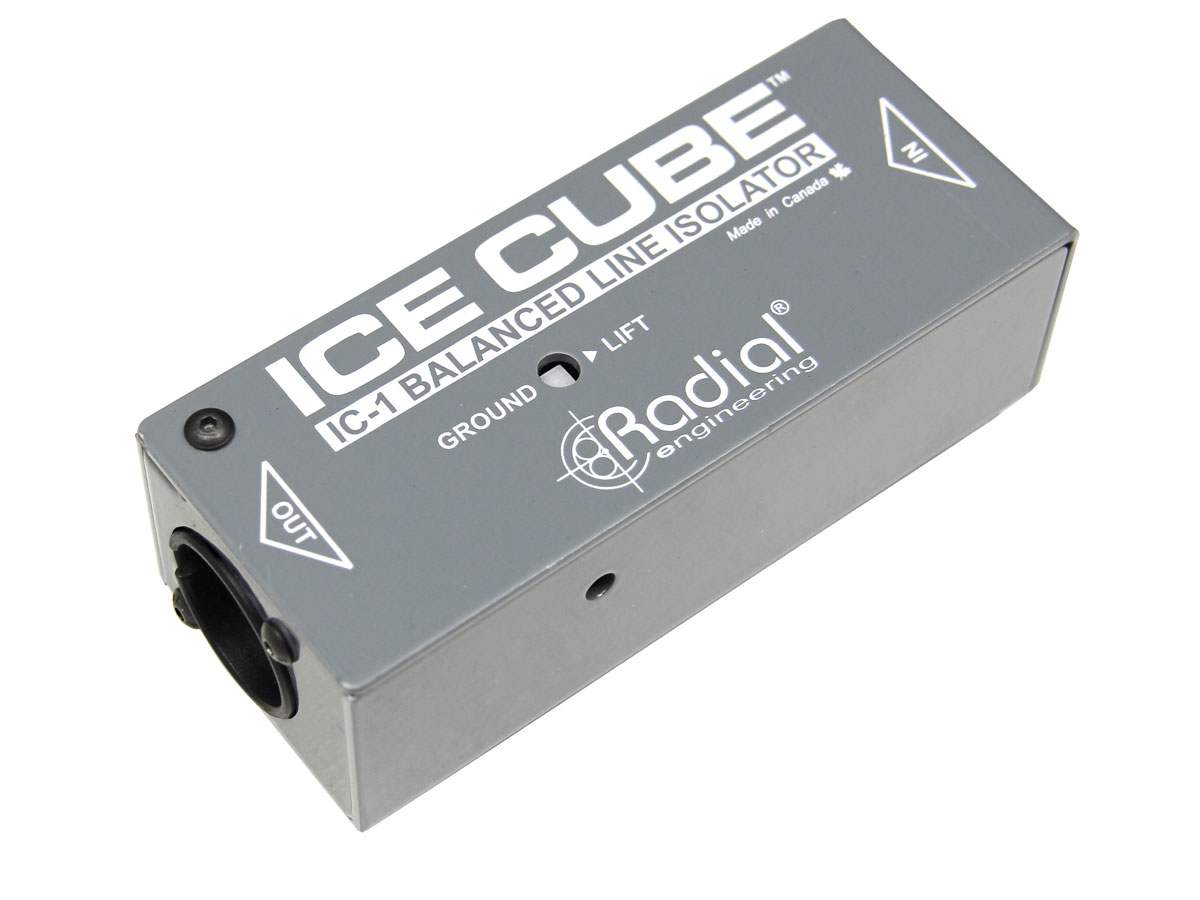
Radial IceCube IC-1
Vancouver, BC - Radial Engineering Ltd. is pleased to announce the IceCube IC-1, an ultra-compact balanced line isolator designed to fit inside a technician's tool kit to eliminate hum and buzz caused by ground loops in audio systems.
Radial Sales Manager Roc Bubel: "The use of isolators to solve noise problems is not new; small plastic units have been around for years. But the problem with these is that they were designed years ago - back when audio systems had limitations both with respect to signal-to-noise, dynamic handling and sound quality. Today, with the advent of digital audio sources, high performance mixers and line array technology, the frequency response and dynamics have increased to the point that those older devices simply cannot keep up. We identified the problem then began looking for a solution some 18 months ago."
"The best way to solve ground loops is to isolate the send and receive devices using an audio transformer. But as any tech will tell you, not all transformers are equal. In fact we spent a huge amount of time testing various transformers in order to come up with a recipe that was compact, had a linear frequency response and could handle a sufficient level for pro use. This in fact is a bit of an oxymoron: the smaller the transformer, the less able it will be to handle bass frequencies and high output signal levels. We are pleased to say that the IceCube does a marvellous job in these areas. It is exceptionally linear from 20Hz to 18kHz, is able to effectively manage the difficult bass region and can withstand pro +4dB balanced signals at 20Hz with less than 0.01% distortion."
Measuring less than 4" x 1 ½" x 1 ½" (10.16 x 3.81 x 3.81 cm), the compact design features an XLR-F input at one end and an XLR-M output at the other with solid 16 gauge steel construction and durable powder coat finish. The steel outer shell provides excellent shielding against electromagnetic fields generated by power cables, dimmers, motors and power supplies while being significantly more rugged - a very important benefit for concert touring and AV rental houses where the fast paced environment can often be very hard on gear. Connection to and from the IceCube is done using standard 3-pin XLR cables. It is also equipped with a ground lift switch to further assist in reducing noise.
Plug and play easy to use, one merely connects the IceCube in series with the offending piece of equipment to solve the ground loop. The IceCube will quietly go to work as it eliminates hum and buzz without compromising the signal quality.
The IceCube IC-1 is now shipping, MAP $59.99 USD.
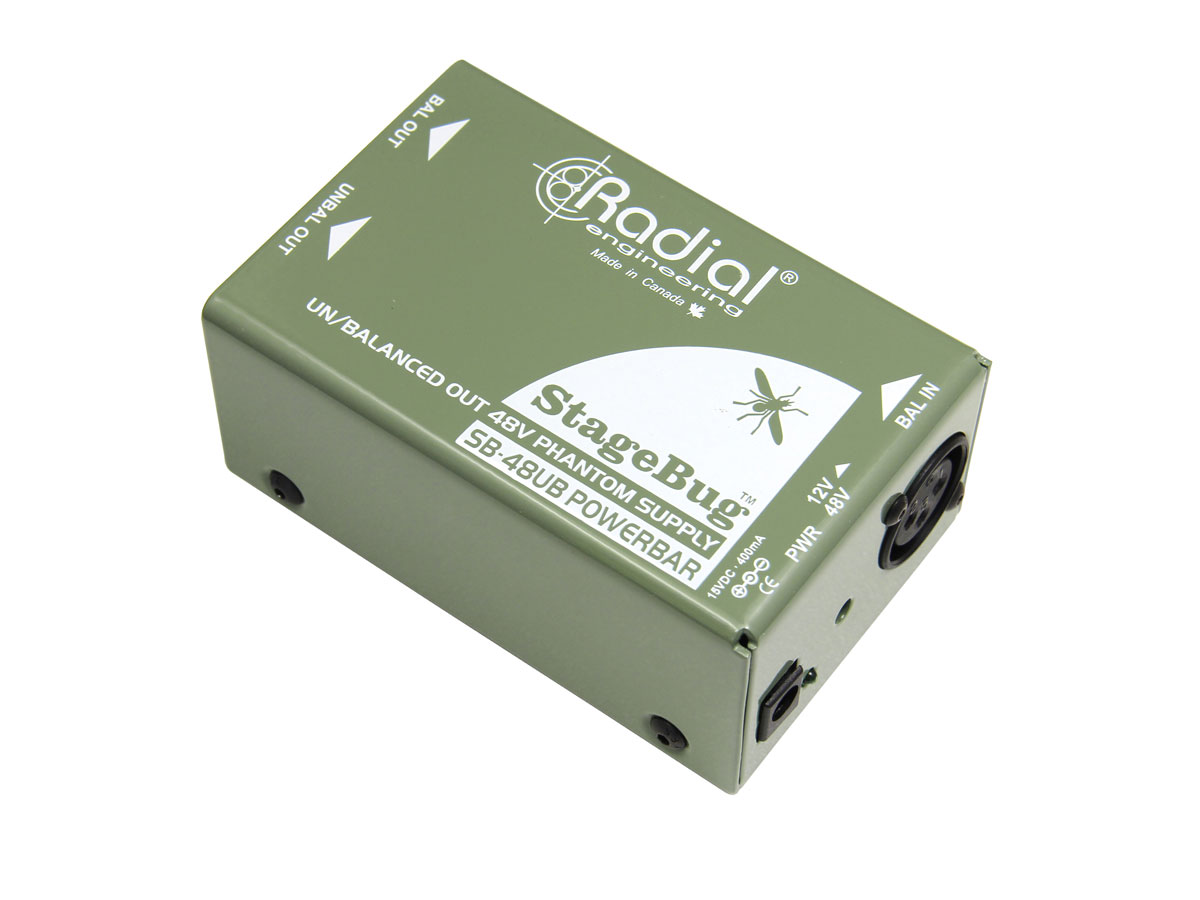
Radial SB-48UB
Vancouver, BC - Radial Engineering Ltd. is pleased to debut the StageBug SB-48UB, a unique phantom power supply that enables a guitar, bass or mandolin player to connect a condenser microphone to a Radial PZ-Pre or PZ-Deluxe.
According to Radial Circuit and Mechanical Designer Nancy Smith: "Over the past couple of years we have seen a tremendous take up of the PZ-Pre on professional stages, particularly with blue grass instruments, acoustic guitars and upright basses. And since the PZ-Pre is able to combine two inputs using a blend function, one can mix two types of pickups together to create the sound. This has led the demand to combine a condenser microphone with a pickup. The SB-48UB takes the balanced input from a condenser and supplies it with 48 volt phantom power. It also outputs an unbalanced signal that is appropriate for the PZ-Pre and the more affordable PZ-Deluxe. This opens the door for artists to use their favorite mic with their favorite preamp pedal."
Made in Canada, the design begins with a solid steel outer shell with an XLR female input to connect the mic. Power is derived from a 15VDC supply and an internal non-radiating charge pump elevates the voltage to 48V for standard phantom power use or it may be set to 12VDC. A choice of balanced XLR or unbalanced ¼" output is available.
Guaranteed for 3 years, the SB-48UB is now shipping with a MAP of $139.99 USD.
MusicRadar is the number 1 website for music makers of all kinds, be they guitarists, drummers, keyboard players, djs or producers...
- GEAR: We help musicians find the best gear with top-ranking gear round-ups and high- quality, authoritative reviews by a wide team of highly experienced experts.
- TIPS: We also provide tuition, from bite-sized tips to advanced work-outs and guidance from recognised musicians and stars.
- STARS: We talk to musicians and stars about their creative processes, and the nuts and bolts of their gear and technique. We give fans an insight into the actual craft of music making that no other music website can.
